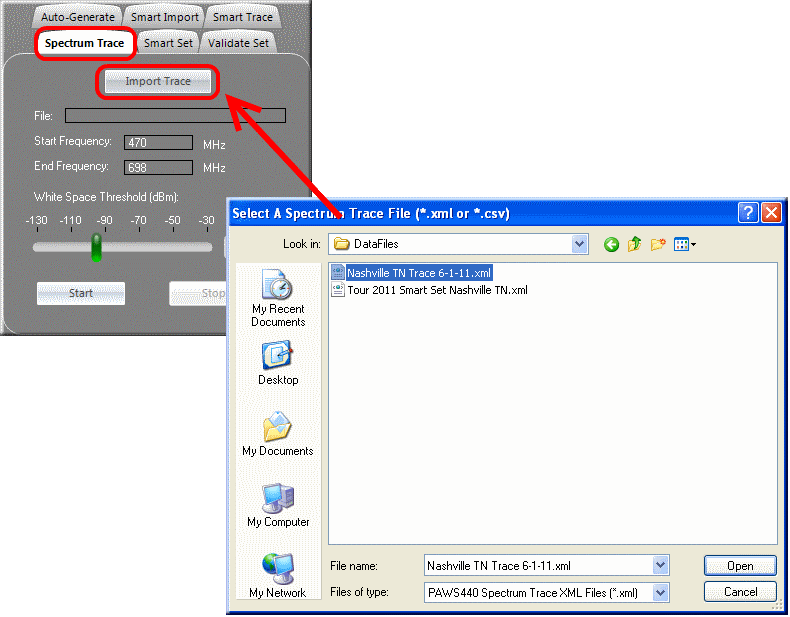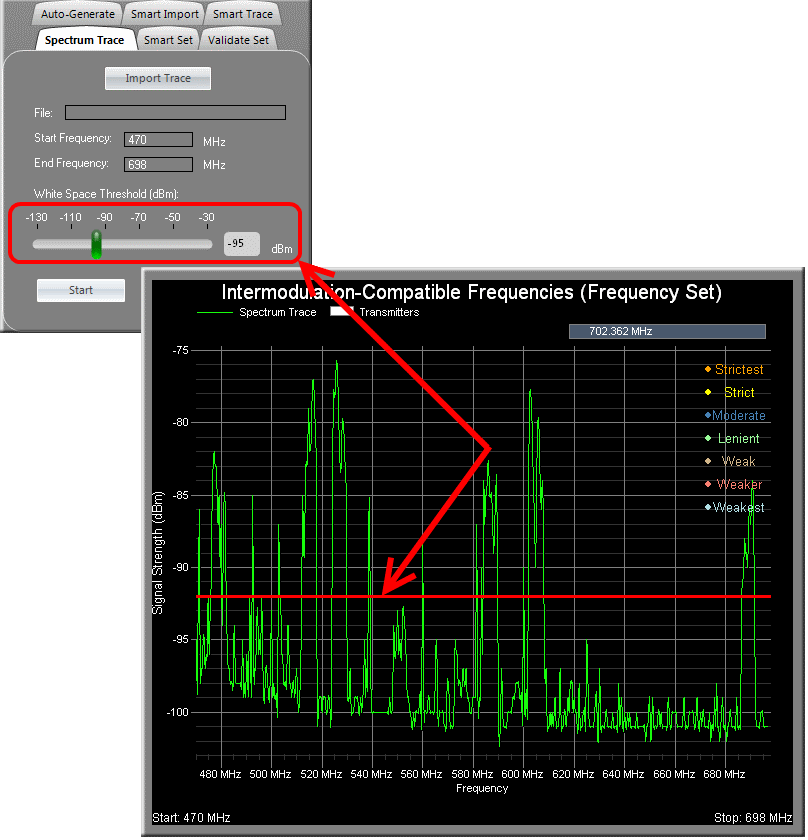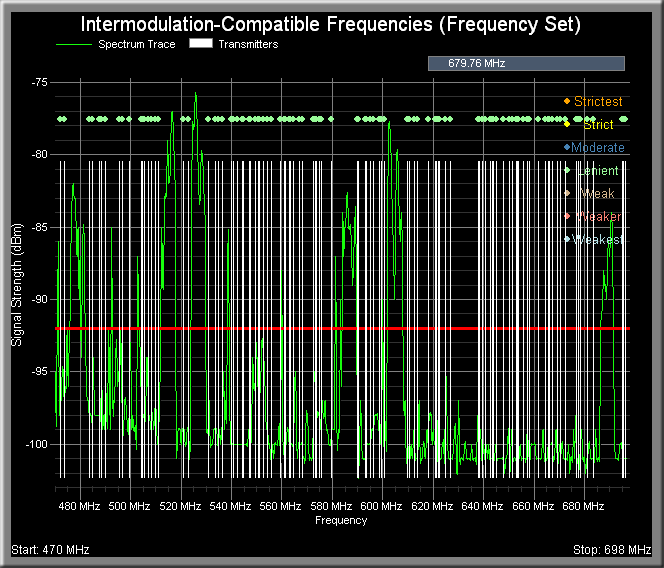
Given an RF spectrum trace, Intermod Assist allows you to generate a frequency set that takes into account interference from both RF interferers and intermodulation products. This is a very powerful feature and it's unique to Intermod Assist.
In this mode you begin by importing an XML file that contains an RF spectrum trace. The format of the XML file must obey the following schema:
<?xml version="1.0" encoding="us-ascii"?>
<paws4400-scans>
<spectrum-trace appid="1737" format="540" date="Friday, April 08, 2011" starttime="10:14:29" white-space-threshold="-55" startfreqhz="550000000" endfreqhz="650000000" pointspertrace="400" signal-strengths-dbm="-96,-98,-95,-93,-97,-95,-95,-97,-96,-93,-94,-94,-96,-95,-98,-97,-99,-96,-99,-97,-99,-95,-95,-94,-94,-97,-96,-97,-99,-98,-98,-96,-94,-90,-81,-80,-71,-67,-62,-56,-52,-48,-45,-40,-38,-36,-34,-32,-30,-30,-32,-34,-36,-38,-40,-44,-48,-52,-56,-59,-66,-73,-78,-82,-89,-98,-98,-99,-93,-95,-96,-94,-97,-97,-94,-98,-93,-93,-96,-98,-95,-93,-98,-97,-93,-96,-94,-98,-95,-99,-97,-95,-93,-99,-98,-96,-95,-99,-99,-98,-96,-96,-98,-96,-96,-93,-95,-99,-97,-97,-93,-99,-94,-98,-97,-93,-96,-95,-94,-99,-96,-98,-93,-97,-97,-99,-96,-96,-93,-96,-95,-96,-93,-87,-85,-76,-73,-68,-60,-55,-53,-48,-43,-40,-38,-36,-34,-32,-30,-30,-32,-34,-36,-38,-39,-45,-48,-52,-56,-60,-64,-70,-78,-82,-88,-96,-97,-96,-95,-97,-97,-98,-93,-98,-95,-93,-96,-98,-93,-98,-99,-96,-94,-93,-94,-93,-96,-96,-96,-96,-93,-96,-98,-94,-96,-93,-99,-97,-93,-99,-96,-96,-96,-95,-96,-98,-96,-94,-96,-94,-94,-99,-95,-93,-98,-94,-95,-97,-98,-94,-94,-95,-96,-94,-93,-97,-98,-99,-95,-95,-97,-94,-93,-93,-83,-77,-72,-68,-58,-56,-52,-48,-44,-40,-38,-36,-34,-32,-30,-30,-32,-34,-36,-38,-39,-44,-48,-52,-56,-61,-67,-73,-77,-81,-90,-98,-93,-96,-94,-93,-97,-98,-94,-97,-96,-97,-99,-95,-98,-95,-93,-95,-94,-96,-97,-97,-99,-97,-98,-99,-95,-96,-97,-93,-99,-96,-98,-93,-99,-96,-99,-96,-99,-93,-94,-93,-98,-93,-96,-98,-98,-95,-98,-96,-96,-96,-93,-96,-96,-98,-93,-93,-98,-94,-98,-97,-97,-96,-94,-96,-93,-96,-95,-89,-81,-79,-72,-65,-59,-57,-51,-49,-43,-41,-38,-36,-34,-32,-30,-30,-32,-34,-36,-38,-40,-43,-47,-52,-55,-59,-67,-74,-78,-86,-90,-97,-96,-94,-93,-94,-96,-95,-94,-96,-94,-96,-99,-96,-96,-95,-95,-96,-94,-96,-97,-96,-96,-93,-98,-98,-98,-99,-96,-99,-96,-96,-95,-96,-93,-96" />
</paws4400-scans>
NOTE: This is the XML schema used by our Pro Audio White Space Finder / RF Spectrum Analyzer (Model PAWS4400).

After the RF spectrum data is loaded then its trace will be displayed -- along with a horizontal, red line that indicates the "White Space Threshold". The 'White Space Threshold' slider controls the threshold signal strength (in dBm) below which is considered 'White Space' -- that is, frequencies not subject to RF interference and which should be considered potential candidates for the frequency set. When you adjust this control you'll see the horizontal, red line move up and down accordingly. Those frequencies whose signal strength amplitudes exceed the threshold are considered off-limits and are locked-out -- that is, they will not be considered as candidates for a frequency set.
In addition to adjusting the 'White Space Threshold' you should select a combination of intermod products you wish to test for from the 'Common Settings'. At this point the computation is very similar to that performed by the 'Generate Frequency Set' mode, the only difference being the initial set of candidate frequencies from which intermod-compatible frequencies are drawn. In the case of 'Frequency Set' mode, all frequencies that fall within the designated frequency range and which are multiples of the step-size are potential candidates. In the case of 'Spectrum Trace' mode, potential candidate frequencies are multiples of the step-size that also fall within the "White Space" -- i.e. below the "White Space Threshold".
After the "White Space Threshold" and 'Common Settings' have been accounted for, press the 'Start' button to begin the computation.

When the computation has completed the intermod-compatible frequencies that compose the frequency set are listed in the 'Results' window. They are also displayed graphically -- as shown above. Here you see that the intermod-compatible frequencies (the vertical white lines) only occur within the "White Space" regions.